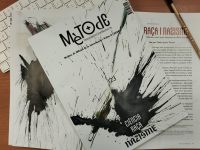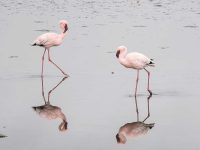A religious past to science
How Biblical stories have contributed to the construction of scientific knowledge
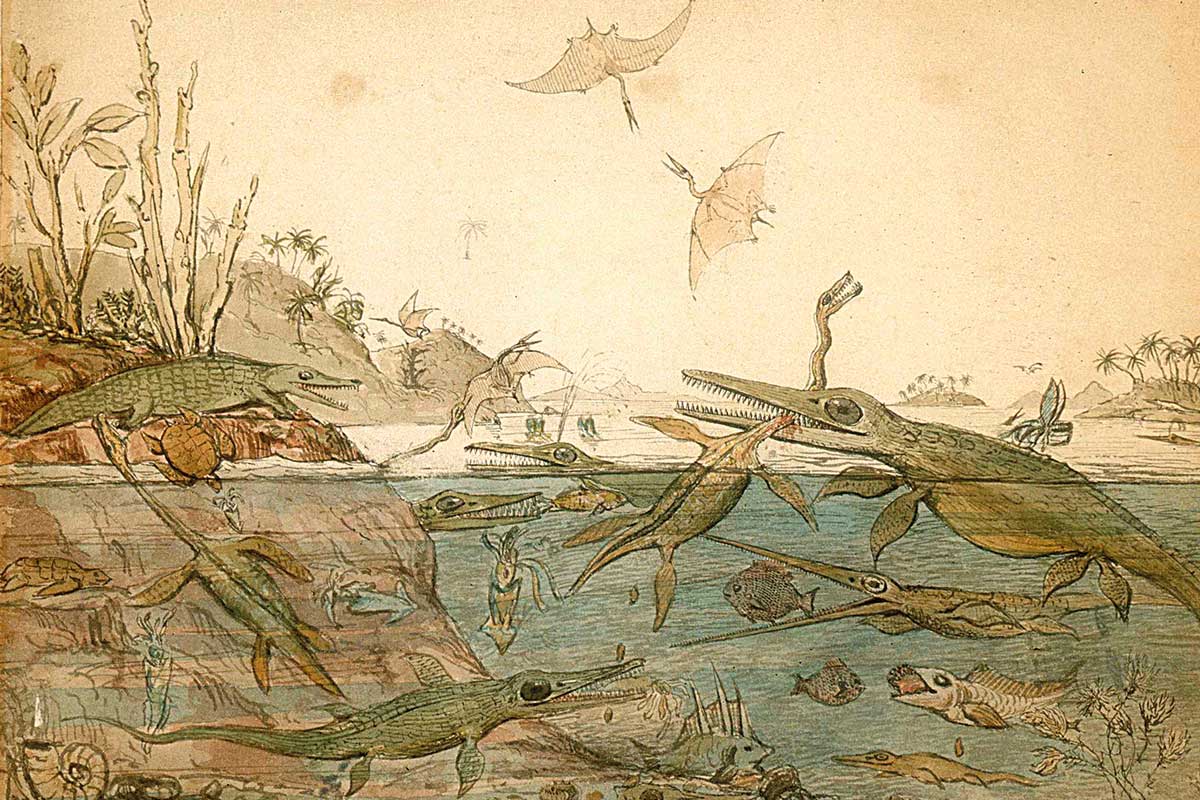
Stories captivate us by speaking to our imagination and by giving order and meaning to our world. Stories not only give us knowledge about society, but they can also shape our understanding of nature. In the Western world, Christianity has provided narratives that were used as references in scientific research for centuries. In this article I discuss two such examples, the Creation story and the story of Noah and the Great Flood, and explain their prevalence in scientific endeavors conducted in the West. These stories were only replaced by alternative ones when new scientific theories and concepts were given sufficient coherence to explain new discoveries.
Keywords: Bible, Creation, Noah’s Flood, fossils, Darwin’s theory of evolution.
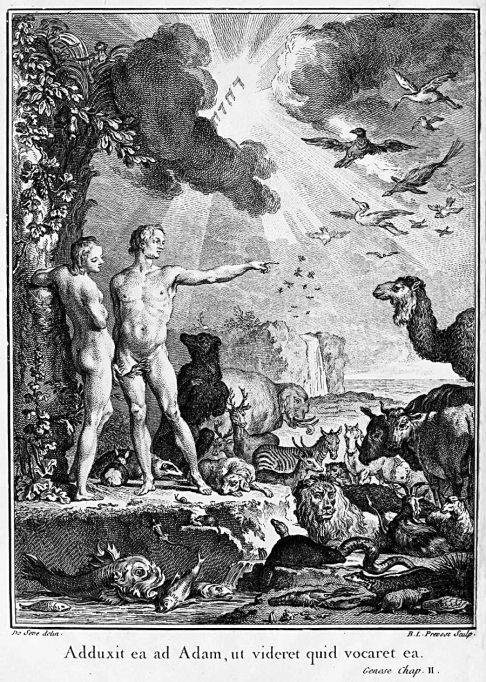
The Creation story was still a reference to 18th-century naturalists. In this frontispiece of Jacques-Christophe Valmont de Bomare’s Dictionnaire raisonné universal d’histoire naturelle (1775), Adam asserts his superiority over the Creation by naming the animals. / Biodiversity Heritage Library
Humans are born in cultural contexts that are permeated by countless stories. The narratives we are exposed to give order and meaning to our world, transmitting social and cultural norms that influence our perceptions and actions (Meretoja, 2018). Narratives are therefore sources of moral knowledge, but they can also shape knowledge about the natural world. Although presocratic thinkers such as Thales of Miletus (c.624–c.545 BC) tried to explain natural phenomena by distancing themselves from the rich collection of myths that circulated in Ancient Greece and considering instead natural causes (Graham, 2018, pp. 163–164), other narratives played important scientific roles in later centuries.
After the rise of Christianity, some Biblical stories were thoroughly discussed as part of scientific inquiries into the structure of the planet and its inhabitants. In this article I focus on two narratives that had a significant impact in certain scientific fields in the Western world: the story of how God created the Earth and every living being (the Creation story), and the story of Noah and the Great Flood. In the 4th century AD, these narratives were present in the Latin Vulgate Bible, which became a reference across Western Europe for centuries, and in its subsequent vernacular translations (Houghton, 2023, pp. XXV–XXVII). At first sight, it may seem odd that stories of religious significance were relevant in the history of science; in reality, attempts to integrate new knowledge of the natural world with Christian theology were common across the Western world until the late 19th century. Cases that are frequently cited as examples of conflict, such as Galileo’s trial, are only a facet of a more complex history of interaction between science and religion (Weldon, 2017, pp. 6–9). In this article I discuss scientific conceptions and practices that were inspired by Christian stories, showing that such conceptions had an enduring influence.
A Great Flood in the history of the Earth
One Biblical story that drove scientific research in the past was that of Noah’s Flood. According to chapter 6 of the Book of Genesis, God became so dissatisfied with His Creation that he decided to destroy it in a great deluge, only sparing one virtuous man, Noah, and his family. God instructed Noah to build a large ark able to withstand the deluge, and to take animals of each species to later repopulate the Earth when the water level subsided. In the 17th century, some naturalists noticed that Noah’s Flood could explain strange occurrences of certain natural objects. For example, fossilized seashells were sometimes found in locations remote from the sea, even at high altitudes. These shells could have been brought during the Flood and then deposited on the soil, ultimately remaining in such places after the water level lowered. If this event had indeed happened, it meant that the Earth could have been quite different before such catastrophe. The diluvial theory therefore favored the notion that the planet had changed through time or, in other words, that it had a history, and that material evidence could be used to reconstruct it (Rudwick, 2014, pp. 34–38, 45–49).
The importance of a Great Flood continued to be asserted during the 17th century, but further discoveries opened the way to challenges to its accepted chronology in the 18th century. For example, newly discovered fossils of aquatic animals contradicted the occurrence of a violent Flood, since their delicate structures were intact (Rudwick, 2014, pp. 79–82). When large bones of massive animals resembling existing vertebrates were discovered later in that century, some naturalists speculated that perhaps the Great Flood had been a much more recent event. In the early 19th century, the naturalist Georges Cuvier (1769–1832) became famous for describing many of these strange animals, showing that they did not resemble any living animals at the time and thus raising the possibility that the antediluvian Earth had not only a different geology, but also a distinct fauna. Various scholars agreed with such view, and reconciled it with their Christian beliefs (Rudwick, 2014, pp. 105–116, 120–127).
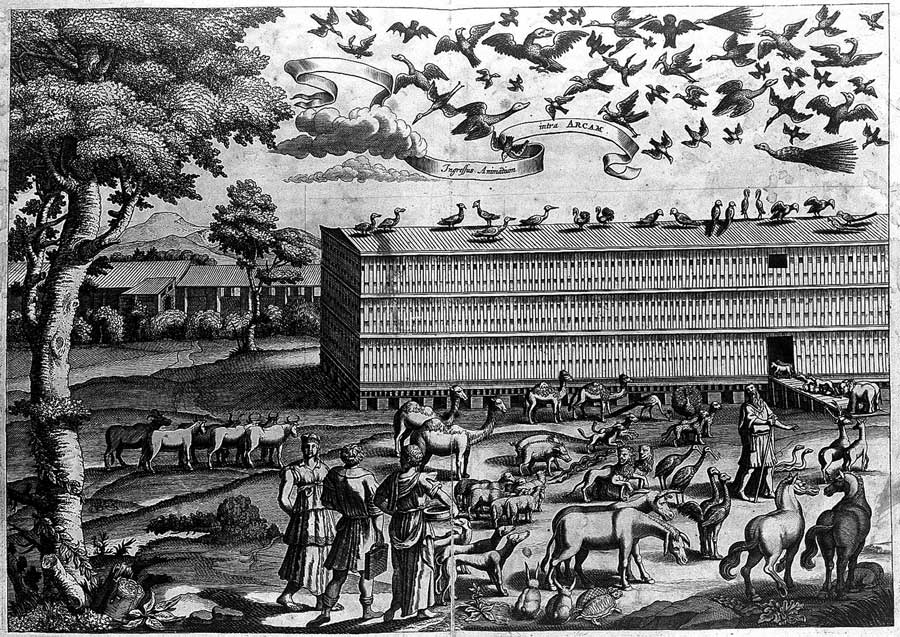
The German Jesuit Athanasius Kircher (1602–1680) was one of the various 17th-century scholars who took the Flood story seriously. In his book Arca Noë (1675), he analyzed the Bible to explain the dimensions of Noah’s ark (see image), how the animals were accommodated there, how much water had poured during the deluge, and how it had disappeared. / Wellcome Collection
Additional startling phenomena were readily explained as a consequence of the Flood. Some of the most remarkable were the «erratic blocks», large rocks that were only identical to the bedrock of areas tens or hundred miles away. Since they were too numerous and heavy to have been moved by humans, naturalists thought that only a major upheaval could have displaced them so far (Rudwick, 2014, pp. 116–118). Rival theories were proposed, but the diluvial theory continued as the most consensual explanation for several decades, and only in the late 19th century did an alternative become plausible. Earlier in that century, the naturalist Louis Agassiz (1807–1873) suggested that the movement of the erratic blocks could be explained by the existence of an «Ice Age» in the past. Aware that glaciers could grow and shrink in size and extension, Agassiz speculated that if the Earth had been covered in snow and ice during a certain period, and if later global temperatures rose and the ice started to melt, large rocks could break and slide down their original place until they dried up and stopped. Such theory was highly speculative when it was proposed in the first half of the 19th century, but as evidence of vanished valley glaciers in the path of the erratic blocks was found in very different locations, it later convinced geologists (Rudwick, 2014, pp. 177–180). The Flood was then reinterpreted by the late 19th century as a past Ice Age of impressive consequences, and the occurrence of a deluge was restricted to a local or regional event of lesser importance, and that had probably produced no significant geological changes (Stiling, 2000, pp. 455–456).
The Creation of all beings and the history of life
The Creation story explained not only the formation of the Earth, but of its living beings. According to chapter 1 of the Book of Genesis, God first created plants, then the animals of the sea, air, and land, and finally humans. The important notion was that the Creation had been divinely designed with organic forms appropriate to each way of life. This constituted a fundamental principle of natural theology, the part of theology concerned with the relationship between God and the natural world. The description of natural specimens was therefore considered a pious activity imbued with religious significance, and a way to demonstrate God’s power and ingeniousness. Classification systems were developed in the 17th century and improved in the following one in an attempt to understand the order that God must have imposed on His Creation (Farber, 2000, pp. 1–21).
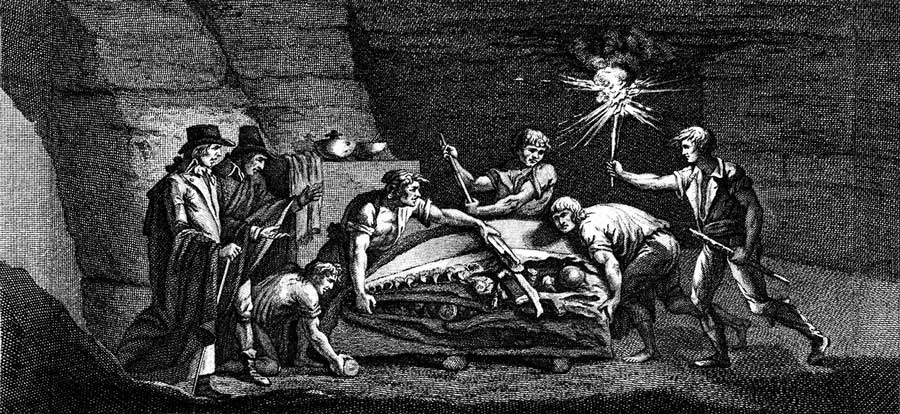
A massive fossil of toothed jaws was retrieved from the quarries around the Dutch town of Maastricht in 1780. At first, naturalists thought that it resembled a whale or crocodile, and some speculated that it could have fallen victim to the Great Flood, if it had indeed occurred more recently. This image in Bathélemy Faujas de Saint-Fond’s Histoire naturelle de la Montagne de Saint-Pierre de Maestricht (1799) dramatizes the moment of the discovery. / Biodiversity Heritage Library
In the 17th century, most naturalists in the Western world agreed that humans had appeared at a quite early time in the formation of the Earth. According to chapter 1 of the Book of Genesis, God had created every part of the universe, including humans, in only six days, and for that reason it was considered that human history had about the same duration as the history of the Earth. This narrative was deemed relevant for the historical research conducted by the «chronologists», a group of scholars who tried to construct a detailed timeline of world history (Rudwick, 2014, pp. 9–11). Chronologists submitted the ancient textual sources to rigorous analysis, including the Bible, which was regarded as an authoritative text. Other scholars, however, argued that the Biblical seven days of Creation did not refer to 24-hour periods, but rather to symbolic and hardly datable moments (Rudwick, 2014, pp. 23–27). In any case, only in the second half of the 18th century did evidence suggest that humans had appeared later in the history of the planet. Fieldwork on exposed sections of the Earth’s crust showed that they formed several layers or strata and contained no evidence of human activity. Since such layers could only have accumulated slowly, during extended periods of time, the planet therefore seemed to have had an extended pre-human past (Rudwick, 2014, pp. 98–102). However, the notion of a long pre-human history on Earth did not contradict the Creation story since it still supported ideas of order and progress present in the Biblical narrative. According to chapter 1 of the Book of Genesis, God created living beings sequentially, from the less complex (plants) to the more elaborate (animals), with humans as the culminating point. New research about the Earth’s crust did show that its different strata had distinctive fossils. The ones in more superficial, hence more recent, layers resembled more closely present-day forms, but most naturalists believed that the differences were probably due to the environmental conditions under which the organisms had lived (Rudwick, 2014, pp. 92–97).
From the early 19th century on, however, Cuvier’s discoveries of strange mammals, such as giant sloths and mammoths, that deviated from their present counterparts too significantly to be only the result of differences in age, sex, or environmental influences did suggest that great extinctions in the past had altered the planet’s fauna. Nevertheless, Cuvier believed that animals had undergone no transmutations because any change from their stable state would likely produce unviable structures before the species had time to adapt to its new forms. Even the discovery of large reptiles, later termed dinosaurs, in older strata and with no present counterparts reinforced the Creation story (Rudwick, 2014, pp. 111–113, 144–147). Although the discovery of extinct animals posed problems – if they were specific to some strata and had not been created by God at the beginning of time, how did they appear later? – these discoveries did not contradict a linear, directional, and progressive view of Creation, with plant and animal fossils of increasing complexity correlative of ever more recent strata.
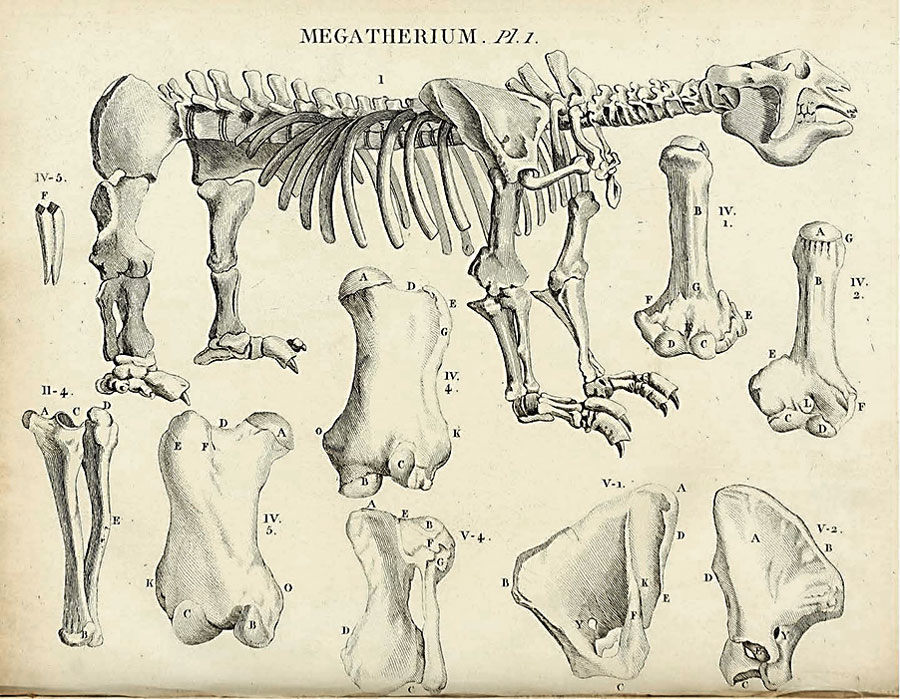
In the late 18th century, Cuvier came across a detailed drawing of a strange South American fossil. He found anatomical similarities with sloths and anteaters, but the fossil was so massive that he argued that it belonged to an entirely new species and named it Megatherium. For him, it was evidence that the ancient Earth had a distinct fauna. The image shows a reproduction of the fossil in Cuvier’s Recherches sur les ossemens fossiles (1812). / Linda Hall Library
Various theories were eventually proposed to account for the transformation of species in the 19th century, but the naturalist Charles Darwin (1809–1882) published a more sophisticated version in 1859. Although the idea of evolution was accepted by naturalists in the following decades, the new mechanism proposed by Darwin, natural selection, was downplayed because he theorized it as blind and purposeless, which contradicted the prevailing views of order and progress in the Creation (Rudwick, 2014, pp. 196–200, 212). His ideas were also controversial because he later argued that humans were, like other animals, the result of evolution from simpler forms. For most naturalists and geologists, the idea of humans as a merely improved monkey threatened the common view of an exceptional and morally responsible humanity made to the image of God (Farber, 2000, pp. 58–67; Bowler, 2009, pp. 207–216).
Where stories and theories meet
The two cases here analyzed show how Biblical stories have influenced Western scientific discussions about the structure of the Earth and its living beings for centuries. These stories provided explanations to natural occurrences and were refined to accommodate startling observations that could contradict the worldviews they portrayed. Alternative theories had to be integrated into new stories that conveyed different worldviews in order to become meaningful to a significant degree. The story of a Great Flood, for example, could not be discredited before a different story concerning the past existence of an Ice Age gained evidence in its support.
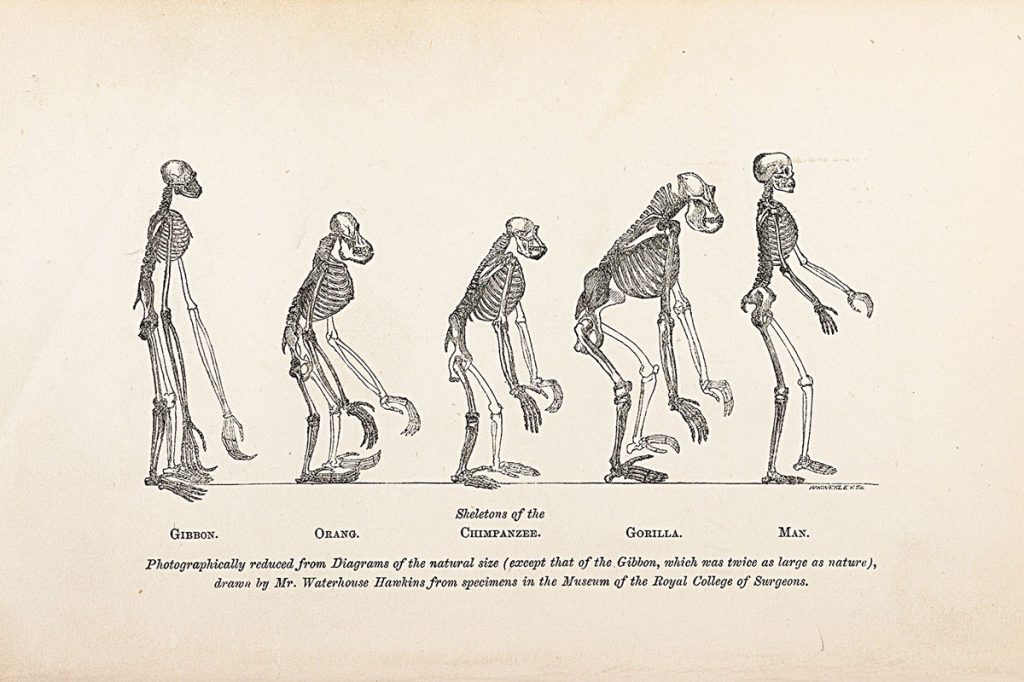
The naturalist Thomas H. Huxley (1825–1895) was one of the most active supporters of Darwin’s theory of evolution in Britain. Before Darwin published a volume in which he applied his theory to the evolution of humans, a topic practically untouched in his first book on evolution in 1859, Huxley readily drew the conclusions in his Man’s place in nature (1863). In its frontispiece, he lined the skeletons of various primates (from left to right, a gibbon, an orangutan, a chimpanzee, and a gorilla), including a human, to highlight their anatomical similarities, arguing for a close evolutionary bond among them. / Wellcome Library
Likewise, Darwin’s theory of evolution was given meaning by being presented in the context of a story in which nature was seen as a battleground, with species fiercely competing for food and mating partners, ultimately driving to extinction less adapted forms. In this alternative story, it was more difficult to accept that nature was a harmonious and purposeful creation of a good and intelligent entity (Bowler, 2009, pp. 297–313). Nevertheless, naturalists and theologians from various contexts tried to reconcile a benevolent view of humankind with Darwin’s theory of evolution. The reactions varied widely in Britain, not to mention other national contexts (Numbers & Stenhouse, 2001; Livingstone, 2014).
The history of science itself can be understood as a meshwork of narratives that try to explain the transformations that different scientific fields underwent throughout time. Such a fact has implications for science education, especially since traditional pedagogies that discard historical knowledge of the sciences have failed to mobilize students in significant ways (Dibattista & Morgese, 2014, p. 2085). I have proposed a methodology to enhance the teaching of scientific subjects by presenting its historical development in the form of a narrative (Gamito-Marques, 2020). This methodology recognizes that stories, even Biblical ones, have shaped scientific knowledge in profound ways, and that historical contextualization can provide a deeper understanding of scientific theories and concepts. In fact, it may provide a way to avoid the polarization of opinion on science and religion, building a common ground that can be of benefit to society.
Funding
This work was funded by a Research Fellowship granted by the NOVA School of Sciences and Technology (Lisbon, Portugal).
References
Bowler, P. J. (2009). Evolution: The history of an idea. The University of California Press.
Dibattista, L., & Morgese, F. (2014). Incorporation of HPS/NOS Content in School and Teacher Education Programmes in Europe. In M. Matthews (Ed.), International handbook of research in history, philosophy, and science teaching. Volume 3 (pp. 2083–2111). Springer.
Farber, P. L. (2000). Finding order in nature: The naturalist tradition from Linnaeus to E. O. Wilson. The Johns Hopkins University Press.
Gamito-Marques, D. (2020). In praise of a historical storytelling approach in science education. Isis, 111, 582–587. https://doi.org/10.1086/711126
Graham, D. W. (2018). Physical and cosmological thought before Aristotle. In A. Jones & L. Taub (Eds.), Cambridge history of science. Volume 1: Ancient science (pp. 163–180). Cambridge University Press.
Houghton, H. A. G. (2023). Introduction. In H. A. G. Houghton (Ed.), The Oxford handbook of the Latin Bible (pp. xxv–xxxvii). Oxford University Press.
Livingstone, D. N. (2014). Dealing with Darwin: Place, politics and rhetoric in religious engagements with evolution. Johns Hopkins University Press.
Meretoja, H. (2018). The ethics of storytelling: Narrative hermeneutics, history, and the possible. Oxford University Press.
Numbers, R. L., & Stenhouse, J. (Eds.). (2001). Disseminating Darwinism: The role of place, race, religion, and gender. Cambridge University Press.
Rudwick, M. J. S. (2014). Earth’s deep history: How it was discovered and why it matters. The University of Chicago Press.
Stiling, R. L. (2000). The Genesis Flood. In G. B. Ferngren (Ed.), The history of science and religion in the Western tradition: An encyclopedia (pp. 453–457). Garland Publishing.
Weldon, S. P. (2017). Science and religion. In G. B. Ferngren (Ed.), Science and religion: A historical introduction (pp. 3–22). Johns Hopkins University Press.


